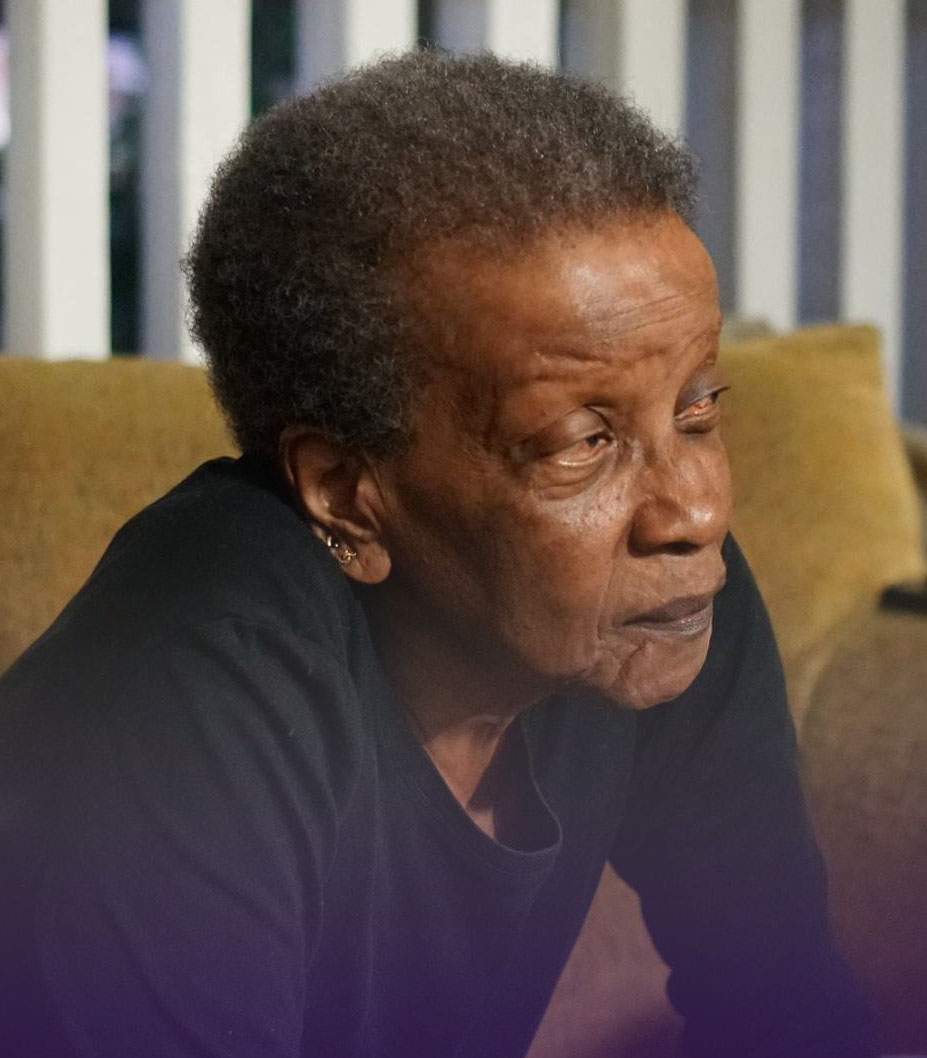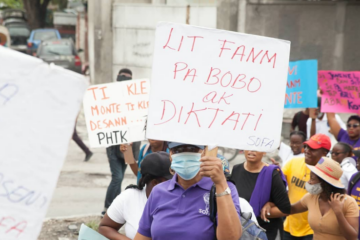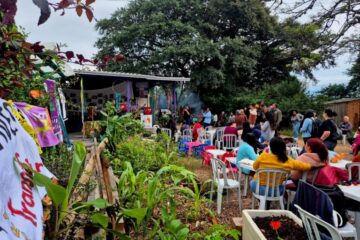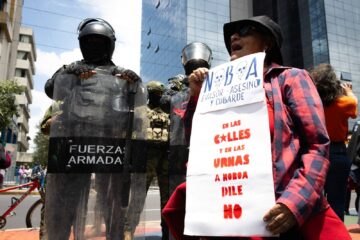Andaiye (1942-2019) was a political militant and thinker from Guyana who dedicated her life to changing the world through women’s organizing at the grassroots of society. The collection The Point Is To Change the World, published by Pluto (2020), tells this story. The first texts of her book allow us to understand the reach and depth of Andaiye’s activism and thought, as well as her personal-political practice of mutual care and challenge to all power relations that structure this society. An example is her critical reflections on medical power and her writings on the networks of affection and care that were necessary in her own battle against cancer since she was diagnosed in 1989.
Andaiye was a name she chose for herself in her adulthood, influenced by the Black movement. The word originally from Swahili means “the daughter who returns home” and is an affirmation of her pride of her African ancestry, as Cleem Seecharam argues. From 1978 to the mid-1990s, she was a member of the Working People’s Alliance (WPA), where she was a militant against authoritarianism, building a revolutionary and mass-based force in Guyana. Looking back at the organization, Andaiye provides a critical reflection on the fact that the dissolution of African-Guyanese and Indian-Guyanese organizations aiming at building the WPA nationally as a union weakened the anti-racist dimension of the socialist struggle in the country.
There is coherence between her historical review and her 2009 writing, where she addresses gender, race, and class from the perspective of contemporary Caribbean struggle. One thing that stands out is her continuing critique of left-wing experiences that overlook or sideline “anti-racist, anti-sexist, anti-homophobic, anti-transphobic struggles and struggles against all forms of exploitation, subjection, and discrimination” on behalf of narrow views that deem class as the primary contradiction. She also insists on the need for self-organizing to make these demands have voice and clout. By that Andaiye does not mean fragmenting the struggles, but actually building unity in political action from organized collective actors. She also asserts criteria to make this unity possible: these must be anti-imperialist and anti-capitalist struggles. She argues: “I don’t pretend to know how we will rebuild the movement to change the (Caribbean) world, and build it better than it ever was, but I am sure that divided action is not taking us in that direction.”
In 1986, Andaiye co-founded Red Thread, a women’s organization in Guyana. She worked in different regional and international areas, focusing on social reproduction work—unpaid or underpaid domestic and care work—as a starting point for women organizing from the grassroots of society, and as a fundamental aspect of an anti-capitalist revolution. This was the feminist and anti-racist lens through which she reviewed and challenged the effects of neoliberalism and the IMF’s structural adjustment programs in the region. Defending the central character of poor women’s leadership and collective mobilization, she challenged the “NGOization” of feminism that followed the implementation of neoliberalism.
There are many inspiring writings in the selection organized by Alissa Trotz in this book that is a must-read to learn about the radical political imagination of anti-imperialist, Black, and women’s struggles in the Caribbean. Capire shares below “Grassroots Women Learning to Count their Unwaged Work,” an account introduced in 2009 about a collective experience that started as an original time-use survey process in Guyana, and which unfolded in the action and care ability of organized women to sustain life amid the floods that affected the country in 2005.
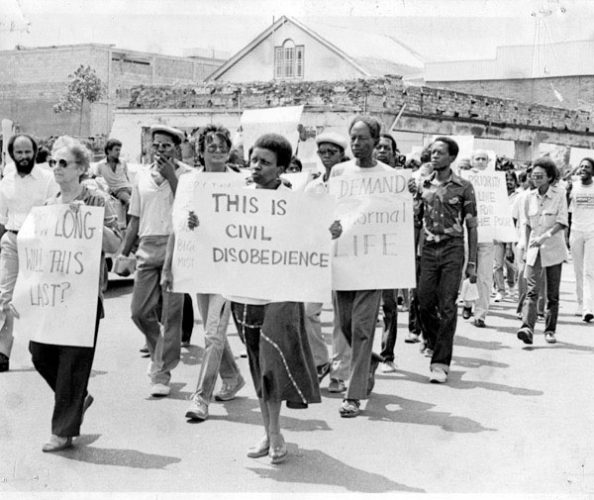
Grassroots Women Learning to Count their Unwaged Work: Summary Report on a 2001–2002 Trial
In a two-year process of preparation for the 1995 Beijing Conference on Women, researchers and activists in the English-speaking Caribbean sought to explain, in material terms, why women remain so concentrated at the bottom of the economic ladder in spite of their clear advances in education: girls and women are so far “outperforming” boys and men in secondary and tertiary education that it has fueled the male marginalization thesis. Since 1995 the
analysis remains the same, particularly the analysis of the extraordinary and growing burden of women’s responsibility for unwaged caring work in the Caribbean. The factors explaining this include the level of poverty and underdevelopment in some countries and areas of countries, which increase the work of ensuring survival.
The findings of a 2001–2002 time-use survey in Guyana by Red Thread, the first of its kind that we know of, confirmed the weight of unwaged work done by grassroots women, showing that in all racial/ethnic groups, the typical working day for the majority of women ranged from 14 to 18 hours, with little help from anyone, often with minimal or unreliable technology, limited access to amenities and with very little leisure or free time for themselves. Several women had longer days—up to 21 hours. The great majority of women were busy by 6:00 a.m., with a significant number of women in all ethnic groups starting earlier, as early as 3:00 or 3.30 a.m. For example, an Indo-Guyanese woman got up at 3:30 a.m. to cook her husband’s breakfast and prepare a packed lunch before he left for work as a cane cutter at around 5:30 a.m. while her three small children, under three years old, slept.1 Many women in all the sectors had no breaks in a day. This was as high as 50 percent among Indigenous women—one of whom lamented it was her day off!
The lack of technology had a major impact on their day.
In some Indigenous communities, the absence of electric light forced women to fit their work into daylight hours, while lack of piped water nearby had women going to the creek several times a day to wash clothes, bathe themselves and their children, and get water for drinking and cooking. For many women in any sector, especially those with small children who were by their side all day, a “break” represented not a cessation of work but a reduction in its intensity; that is, they stopped tackling more than one job at a time. For many women in all sectors the only time they could call their own was a few minutes’ prayer or devotion at the beginning and end of their day. Illness and pregnancy sometimes slowed 118 the point is to change the world women down but clearly did not stop them doing a full day’s work, including heavy jobs such as chopping wood. And any working day could unexpectedly be stretched to 24 hours, for example, when a child was ill and needed attention through the night as one mother recorded, which does happen to every mother of a young child (IWCN 2004).
In the Red Thread organizer Wintress White recounted how the group responded:
We went into the communities on the coast that were badly hit by the flood. We went there to find out how the people were coping and to see if children and people who had chronic illnesses were sick, and if so who we could approach to get help for them (More precisely our participation in the delivery of flood relief targeted ‘elderly people, pregnant and breast-feeding mothers, people with disabilities and women with young children’). News soon spread that Red Thread was the place to go to for help and Indo-Guyanese and Afro-Guyanese women—even men—came to see what help they could get. We told them that even if we were in a position to give them food, and we were not, when the food was finished, then what? We told them that they should organize themselves together and make some demands to the government as they were not responsible for the flood. We started to organize meetings so they could prepare… At one meeting grassroots women learning to count unwaged work 119 in our small centre there were about 220 women from 14 communities— Indo-Guyanese and Afro-Guyanese.
process of compiling the time-use diaries, whether they were writing themselves or dictating to a Red Thread woman what to write, the women revealed their work to themselves, and in some cases developed a confidence that this work entitled them to the resources they needed to reduce their burden.
That consciousness was the underpinning of Red Thread’s organizing with hundreds of grassroots women to demand support following the worst flood in Guyana’s history in January/February 2005. At that time, of Guyana’s total population of just over three-quarters of a million, three hundred thousand people in 110 villages or nearly 40 percent of the population was affected:
Entire communities lived under stagnant and contaminated water (more than four feet deep in some places), accessible by boat, or the vessels— upturned fridges, boards lashed to oil drums—improvised by residents. The shelters that the government opened offered temporary relief to less than six thousand persons, leading many to decamp to the coastal main road in search of dry land, food and potable water. Households suffered extensive losses that included furniture and personal effects, vegetable gardens, farmlands, poultry, livestock and outdoor equipment. Of the 34 deaths, seven were due to drowning; the rest were the result of flood-related illnesses, with hundreds admitted to hospital. (Trotz 2010)
Women were in the forefront of every activity in their communities after the flood. The Minister of Labour, Human Services and Social Security acknowledged this when she said, “It is the women of Guyana who defended their children from disease and death during the flood”, in a meeting on March 9, 2005, organized by the Women’s Affairs Bureau and women’s groups to mark International Women’s Day 2005.
But the Red Thread organizers wanted more than this acknowledgement. They were determined that the women’s defense of their families and communities would be counted as work and that its full spectrum of skills, creativity and dedication to life be seen.
Thus the language they used was of “the grassroots women of every race who braved waist-deep and even chest-deep flood waters… to invent ways to feed, clothe, shelter, teach, nurse, worry about and provide safety and a sense of security for their children first of all” (Red Thread 2005).
Counting the work in turn opened the way to demanding that the women were entitled to resources to do the mountain of work of restoring lives and livelihoods. This led Red Thread to the decision to hold a speakout at which the women would speak their minds about their experience and needs and demands to representatives from the media, parliament, trade unions, government units, local NGOs and international donor agencies. The women wrote lists of the household goods and stocks and animals and kitchen gardens they had lost, what extra workload they were carrying, and what their demands were on government and other agencies (Red Thread 2005).
“Grassroots Women Speak Out: Counting our Work for Guyana’s Survival from the Flood” was held in Georgetown on March 13, 2005 with representatives from all those institutions and agencies hearing the testimony and the demands of the more than two hundred Indo-Guyanese, Afro-Guyanese, Mixed race and Indigenous women who had gathered. In a written statement
later published in the media, the women prefaced these demands by describing themselves in terms of the unwaged, subsistence and low-waged work they usually did and how the products and tools of their labor had been damaged or destroyed:
“We are mothers, grandmothers, aunts, daughters and sisters who care for our families full-time without any wage, or who care for our families and also work outside the home for low wages. We are women with disabilities and women looking after children with disabilities.
“We are cane farmers who lost our crops and who are unable to replant and unable to pay leases for farmland. We are garment workers, security guards, domestics, newspaper vendors and other women with jobs outside the home who were not able to earn even our usually low wages during the flood.
“We are market vendors, fish vendors and vendors of snacks and other goods who lost our stocks to the flood and who cannot restock because we have no money and no one is willing to trust us money. We are farmers, vendors and other small businesswomen who owed installments (sic) on loan repayments. We are housewives and caregivers who suffered massive losses of household possessions, kitchen gardens, poultry and small livestock.
“We are not asking anyone for handouts; but we do want what we are entitled to – the actions we need all of you to take so we can continue to ensure the survival of our children, families and communities without the impossible burden we have been carrying since the flood started.” (Red Thread 2005)
In material terms, the women’s organizing helped win a small amount of compensation, replacement for small livestock and plants lost, and assistance from the ministry of agriculture to villages that it had not visited. But they won much more than that; they won the invaluable experience of mobilizing and organizing to win, and of winning.

REFERENCES
IWCN. 2004. “Report on Red Thread Time-Use Survey.” November 30. International
Women Count Network.
Red Thread. 2005. Organizing for Survival: Grassroots Women and the Flood. DVD and transcripts. Georgetown: Red Thread Women’s Organisation.
Trotz, D. Alissa. 2010. “Shifting the Ground Beneath Us: Social Reproduction, Grassroots Women’s Activism and the 2005 Floods in Guyana.” Interventions: Journal in Postcolonial Studies 12(1): 112–124.
Wintress White. 2009. “January–March 2005: Grassroots Women in Guyana Organizing to Regain our Lives and Livelihoods after the Worst Floods in Guyana’s History.” Presented at Floods, Drought, Pollution and Survival: Women from the Global South Speak out about Climate Change, February 5, 2009, London, UK.

